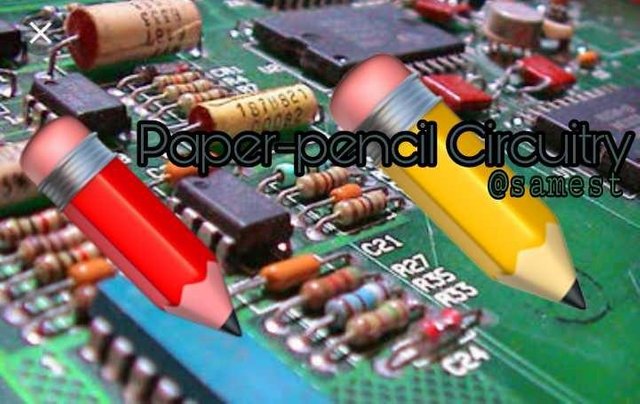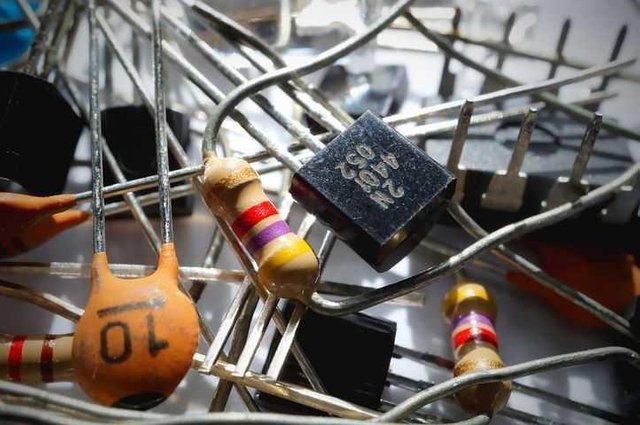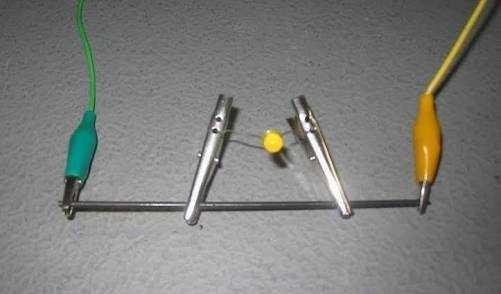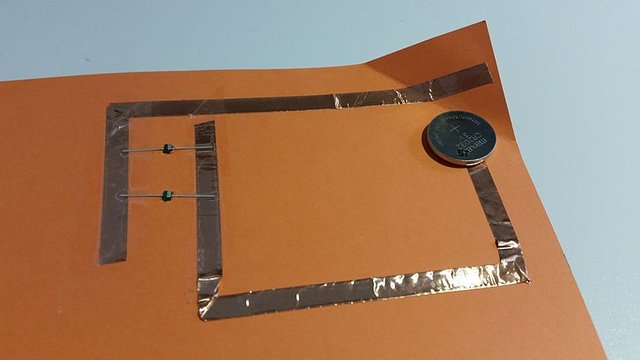Paper-based Electronics Circuitry by samest
Electrical Engineering is an interesting study though is wide when you look at the majority of types of equipment, device or gadgets we use it can be traced down to the study and application of the electrical system. In case you are not aware of Electrical Engineering has two important aspects which areelectrical and electronic. The Electrical aspect deals with the power system, generation, distribution, and transmission while Electronics talks about communication that makes use of active and nonlinear components.
Today, I will share one of my experience on Electronics in Paper and Pencil. Some months back I wrote a little zappl on this topic, check outElectricity Paper and Pencil Circuit by samest
When searching for the easiest and simplest way to establish a graphitic circuitry especially in solvent-free manner, drawing with pencil on paper is the answer. I will show you how in a moment.

Day-to-day discoveries in the area of technology have to increase innovation and solution to many problems in our environment. During my engagement as an electrical engineer, I got the clearer understanding about paper-based electronic.
What do I mean by paper-based electronics?
This simply means there is Oita of electrical conduction in paper and pencil which an electronic circuit. A circuit is a complete close system. There are some elements that made up of this proves. Let’s look at them one after the other.
A Graphite:
In the study of the element in chemistry, there is what we called allotrope of carbon. Allotrope in general terms means an element can appear in two or more forms. Graphite is an allotrope of carbon. Carbon belongs to group 4 element as a non-conducting element but graphite on the other hand conduct.
The element is a remarkable one for a large variety of materials that can be produced from its basic form like extremely strong fibers, easily sheared lubricants, gas-tight barriers, and gas absorbers. due to the fact that graphite describes itself as an ideal perfect graphite structure and has no defect, this makes graphite an element commonly used to describe graphitic materials.
Lets search for this element called graphite
From the research, graphite can be found in the form of minerals on a rock and it is usually a metamorphic rock, same place to discover marble and gneiss. This element is being layered due to this characteristics graphite can be deposited on a rough surface through a process called Exfoliation with an application of slight force on the element. The natural black color and the little explanation above are part of what impressed the early literate to make use of graphite as a tool to make an impression on surfaces.
This is the genesis of Pencil invention in the 16th century.
Component of A Pencil
The production of a pencil can be traced down to some element mixture. The elements are nanocomposite of graphite with intercalated clay particles and a tiny amount of wax. The ratio of graphite in quantity to the clay content that determines the types/category of a pencil. Pencil types are of two types which are H and B
The H in this context means the higher clay which is hardness while B is the higher graphitic content which results to the blackness of the pencil lead.
The application of pencil is incomplete in absent of paper. Paper is an element or tool that forms an ideal surface for exfoliation of graphite particles release from pencils via a process called Mechanical Abrasion and this lead to black deposit on paper called Pencil Trace.
Fact Revealed
Pencil Trace which is the black deposit via mechanical abrasion process contain interconnected numerous graphene layers, thereby its allow the passage of an electron through them despite the introduction/presence of insulating clay particles.
Not every paper support pencil trace. The paper types that supported the black deposit has different roughness and the more the roughness characteristics the larger graphene layers deposited coupled with small interconnectivity which is present in graphitic deposits of the pencil trace.
Now, let dig deeper into the paper as a platform or board for writing a flexible electronic circuitry.
Graphite Resistors on Paper
The resistor is one of the most used components in electronics. This is a component comprises of the passive electrical terminal which uses electrical resistance as a circuit element.
Wikimedia For Circuit Below: By: Cyril Mechkov-- Ohm's Law Graphite Led
 |  |
Paper-Pencil Circuit Application
There are different areas where the paper-pencil circuit can be used. Below is the list of some of the application:
- Paper Pencil Circuits as a Conducting Track
In the history of electronic, we have a solderless breadboard and stripboard are in use. The pads or let me say the conventional wires are made from the metallic element (Aluminium or Copper).
From the perception of Paper Pencil circuit, create a path with a pencil on a paper(graphitic paths), this serves as a conducting track which can be utilized in fabricating paper-based functional devices (Ultraviolet sensor and Microfluidic sensor). The innovation discovered for UV sensor paper-pencil circuitry has been cost-effective and the track for graphitic was made through pencil drawing which is the electrodes pads on paper.
- Paper Pencil Circuit as Sensing Element
Black deposit(pencil-traces) is employed as sensing elements mechanical force which lead to the production/fabrication of piezoresistive and chemiresistive and biosensor. From the research, Santiago and Kubota developed one simple approach for glucose biosensing by use of paper-based technology with the graphitic electrode.
- Paper Pencil Circuit as an Energy Storage Devices
Here, two processes are involved which are Faradaic and Non-Faradaic. Storing charges in electrical electronic engineering can be traced down to all electrochemical energy storage devices like supercapacitors and batteries. The use of pencil drawing as an electrode material is in use during the fabrication of these devices.
In conclusion, Pencil drawing is not that simple, inexpensive or solvent-free techniques but due to lightweight, resistance to heat and radiation and even chemical stability, pencil drawing become one of the top stories everywhere when fabrication of different kinds of passive and active circuits is been mentioned.
The little set back designer must encounter is, paper as an element is hygroscopic, which means any amount of moisture on it can give rise to ionic currents, this can affect the electrical properties of the trace on paper. It is advisable to laminate the pencil trace on the paper to obtain stable device performance.
Thanks for reading.
Find more information check below references.
Made how.com: How Pencil is Made by Petroski, Henry
M. S. Dresselhaus and G. Dresselhaus, Adv. Phys., 2002, 51,
1–186.A Popular Science Site; When Carbon Become an Electrical Conductor by: Adam Weiner
A PDF file via Google Scholar; Graphitic Structure by Jonathan Philips & Joe Cordaro
Quora Website; Reason Behind the Conductivity of a Graphite by Bindu Bindu

Do you blog on science, engineering, mathematics or technology or you are new on steemSTEM, the please join us on our Discord channel and please check out the posts on #steemstem!

Hello! I find your post valuable for the wafrica community! Thanks for the great post! We encourage and support quality contents and projects from the West African region.
Do you have a suggestion, concern or want to appear as a guest author on WAfrica, join our discord server and discuss with a member of our curation team.
Don't forget to join us every Sunday by 20:30GMT for our Sunday WAFRO party on our discord channel. Thank you.
Congratulations! This post has been upvoted from the communal account, @minnowsupport, by 💕💕samest💥™° from the Minnow Support Project. It's a witness project run by aggroed, ausbitbank, teamsteem, someguy123, neoxian, followbtcnews, and netuoso. The goal is to help Steemit grow by supporting Minnows. Please find us at the Peace, Abundance, and Liberty Network (PALnet) Discord Channel. It's a completely public and open space to all members of the Steemit community who voluntarily choose to be there.
If you would like to delegate to the Minnow Support Project you can do so by clicking on the following links: 50SP, 100SP, 250SP, 500SP, 1000SP, 5000SP.
Be sure to leave at least 50SP undelegated on your account.
Wow! Having a circuit drawn with pencil is really cool bro. I think I might have to try it out.
Thanks for sharing bro
Thanks for your submission
@resteemator is a new bot casting votes for its followers. Follow @resteemator and vote this comment to increase your chance to be voted in the future!
This post has been voted on by the steemstem curation team and voting trail.
There is more to SteemSTEM than just writing posts, check here for some more tips on being a community member. You can also join our discord here to get to know the rest of the community!
Do or do not. There is no try.
SOOOOOOO SALLY CAN WAIT!!!!!!!!!!!!!